Disposal of Fire Extinguishers
Overview
Description: Fire extinguishers are portable devices designed to extinguish small fires. They contain different types of extinguishing agents suitable for various classes of fires, including water, foam, dry chemical, carbon dioxide (CO₂), and halon.
Label Information
Contents: The specific extinguishing agent contained in the fire extinguisher. Common types include:
Water: For Class A fires (ordinary combustibles).
Foam: For Class A and B fires (flammable liquids).
Dry Chemical: For Class A, B, and C fires (ordinary combustibles, flammable liquids, and electrical equipment).
Carbon Dioxide (CO₂): For Class B and C fires (flammable liquids and electrical equipment).
Halon: For Class B and C fires (flammable liquids and electrical equipment), although being phased out due to environmental concerns.
UN Numbers:
Water Extinguisher: Generally not classified under UN numbers.
Foam Extinguisher: UN 1044
Dry Chemical Extinguisher: Varies based on the chemical used.
CO₂ Extinguisher: UN 1013
Halon Extinguisher: UN 1044
Purpose of UN Numbers: These numbers identify specific extinguishing agents for transport and emergency response purposes.
Hazard Symbols:
Non-Flammable Gas Symbol: For CO₂ extinguishers.
Warning Information:
Handling Instructions: Follow instructions for use as indicated on the label. Ensure correct type of extinguisher is used for the specific class of fire.
Emergency Procedures: The label may include instructions for use in emergencies, such as pulling the pin, aiming the nozzle, squeezing the handle, and sweeping the base of the fire.
Physical and Chemical Properties
Appearance: Typically a red cylinder with a hose or nozzle. Sizes vary from small handheld units to larger wheeled models.
Odour: Varies depending on the extinguishing agent; CO₂ is odourless, while dry chemicals may have a slight odour.
Boiling Point: Varies by extinguishing agent.
Melting Point: Varies by extinguishing agent.
Density: Varies by extinguishing agent.
Molecular Weight: Varies by extinguishing agent.
Health Effects
Acute Exposure: Health effects depend on the specific extinguishing agent:
Water: Minimal health effects; can cause slip hazards.
Foam: Can cause skin and eye irritation.
Dry Chemical: Can cause respiratory irritation, skin and eye irritation.
CO₂: Can cause respiratory distress or asphyxiation in confined spaces.
Halon: Can cause dizziness and respiratory issues; has ozone-depleting effects.
Chronic Exposure: Prolonged exposure to some agents, especially dry chemicals and halon, can lead to long-term respiratory issues.
Skin and Eye Contact: Some agents can cause irritation or chemical burns upon contact with skin or eyes.
Reactivity and Compatibility
Reactivity: Most extinguishing agents are stable under normal conditions. However, they can react with certain materials:
Dry Chemical: Can react with acids and other chemicals.
Foam: Can react with combustible materials.
CO₂: Non-reactive, but can displace oxygen.
Incompatible Materials: Specific incompatibilities depend on the extinguishing agent used.
Environmental Impact
Water and Foam: Generally safe, but can cause runoff issues and contamination.
Dry Chemical: Can leave residues that may be harmful to the environment.
CO₂: Minimal environmental impact, but high concentrations can affect local fauna.
Halon: Significant environmental impact due to ozone depletion; phased out under the Montreal Protocol.
Applications
Residential: Used for home safety to extinguish small fires.
Commercial: Employed in offices, retail spaces, and public buildings.
Industrial: Used in manufacturing plants, laboratories, and other industrial settings.
Vehicles: Carried in cars, boats, and aircraft for emergency use.
Safety Measures
Storage: Store in an accessible location, away from direct sunlight and extreme temperatures. Regularly inspect for damage and check pressure gauges.
Handling: Ensure familiarity with the operation of the extinguisher. Conduct regular training and drills.
Protective Equipment: Use personal protective equipment (PPE) if necessary, such as gloves and eye protection, especially when using chemical extinguishers. Ensure that all personnel are trained in the proper use of fire extinguishers and emergency response procedures.
Regulatory Information
Occupational Safety: Follow guidelines provided by regulatory bodies such as OSHA (Occupational Safety and Health Administration) for workplace safety.
Transport Regulations: When transporting fire extinguishers, they must be properly labeled and packaged according to international regulations, such as those set by the International Air Transport Association (IATA) and the International Maritime Organization (IMO).
How to dispose of old fire extinguishers
Fire extinguisher recycling near me
Where to dispose of fire extinguishers
Can you throw away a fire extinguisher?
Fire extinguisher disposal hazardous waste
Fire extinguisher disposal regulations
How to recycle a fire extinguisher
Expired fire extinguisher disposal
Fire extinguisher disposal UK
Local fire extinguisher disposal sites


